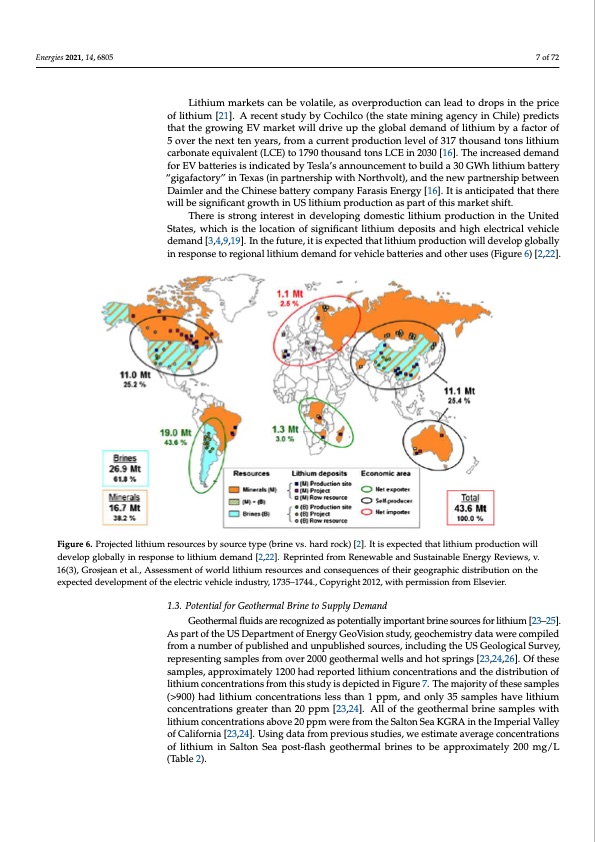
PDF Publication Title:
Text from PDF Page: 007
Energies 2021, 14, x FOR PEER REVIEW 7 of 74 Energies 2021, 14, 6805 Figure 5. Predicted increase in worldwide demand for lithium and other battery materials due to growth of the EV and battery storage markets [20]. It is estimated that lithium demand in 2050 will be over 2 million tons LCE [20]. Creative Commons Attribution (CC BY 3.0 IGO). 7 of 72 Lithium markets can be volatile, as overproduction can lead to drops in the price of lithium [21]. A recent study by Cochilco (the state mining agency in Chile) predicts that Lithium markets can be volatile, as overproduction can lead to drops in the price the growing EV market will drive up the global demand of lithium by a factor of 5 over of lithium [21]. A recent study by Cochilco (the state mining agency in Chile) predicts the next ten years, from a current production level of 317 thousand tons lithium carbonate that the growing EV market will drive up the global demand of lithium by a factor of equivalent (LCE) to 1790 thousand tons LCE in 2030 [16]. The increased demand for EV 5 over the next ten years, from a current production level of 317 thousand tons lithium batteries is indicated by Tesla’s announcement to build a 30 GWh lithium battery carbonate equivalent (LCE) to 1790 thousand tons LCE in 2030 [16]. The increased demand fo“griEgVafabcatoteryri”esinisTienxdaisca(itnedpabrytnTerslhai’psawninthouNnocretmhveonlt)t,oabnudiltdhean3e0wGpWarhtnlietrhsihuimpbeattwteereyn “gDiagiamfalcetroarnyd”itnheTeCxhaisn(eisnepbarttneeryrschoipmwpaitnhyNFoarathsivsoEltn),eargnyd[t1h6e].nIetwispaanrttincieprashteidptbheatwttehenre Dwailml blersaignndiftihceanCthginroewsethbaintteUryS cliothmiupmanyprFoadruascitsioEnnaesrgpyar[1t 6o]f. tIhtiismanatrikcieptastheidft.that there willbeThsiegrneifiiscasntrtognrgowinthterinesUtSinlitdheivuemlopriondgudcotimonesatsicplairthtioufmthipsrmodaurkcetitosnhifnt.theUnited StateTsh,ewrehicshstirsonthgeinlotcearetisotninofdesivgenloifpicianngtdliothmiuesmticdleipthoisuimts apnroddhuicgthioneleinctrtihcealUvneihteicdle Sdtaetmesa,nwdh[i3c,h4,9is,1t9h]e.Ilnocathtieonfuotufrseig,nitifiicsanextplietchtieudmthdaetploitshitisumandprhoidguhcetiloenctrwiciallvdehvieclloep dgelmobaanldly[3i,n4,9r,e1s9p]o.nInsethteofuretugrieo,niatlisleitxhpiuecmtedtehmaatnlidthifuomr vperhodiculectiboanttweriilelsdeavnedlopotghleorbaulslyes in(Friegsuproen6s)e[t2o,2r2e]g.ional lithium demand for vehicle batteries and other uses (Figure 6) [2,22]. Figure 6. Projected lithium resources by source type (brine vs. hard rock) [2]. It is expected that lithium production will Figure 6. Projected lithium resources by source type (brine vs. hard rock) [2]. It is expected that lithium production will develop globally in response to lithium demand [2,22]. Reprinted from Renewable and Sustainable Energy Reviews, v. develop globally in response to lithium demand [2,22]. Reprinted from Renewable and Sustainable Energy Reviews, v. 16(3), Grosjean et al., Assessment of world lithium resources and consequences of their geographic distribution on the 16(3), Grosjean et al., Assessment of world lithium resources and consequences of their geographic distribution on the exepxpecetcetdedddeveveleoloppmmenent tofofththeelelcetcrtircicvevhehicilceleinidnduustsrtyr,y1,713753–51–71474.4, .C, oCpoypryigrihgth2t021021,2w, withithpepremrmissisiosinonfrofrmomElEselsveiveri.er. 1.3. Potential for Geothermal Brine to Supply Demand 1.3. Potential for Geothermal Brine to Supply Demand Geothermal fluids are recognized as potentially important brine sources for lithium [23–25]. Geothermal fluids are recognized as potentially important brine sources for lithium As part of the US Department of Energy GeoVision study, geochemistry data were compiled [23,24,25]. As part of the US Department of Energy GeoVision study, geochemistry data from a number of published and unpublished sources, including the US Geological Survey, were compiled from a number of published and unpublished sources, including the US representing samples from over 2000 geothermal wells and hot springs [23,24,26]. Of these Geological Survey, representing samples from over 2000 geothermal wells and hot springs samples, approximately 1200 had reported lithium concentrations and the distribution of [23,24,26]. Of these samples, approximately 1200 had reported lithium concentrations and lithium concentrations from this study is depicted in Figure 7. The majority of these samples the distribution of lithium concentrations from this study is depicted in Figure 7. The (>900) had lithium concentrations less than 1 ppm, and only 35 samples have lithium majority of these samples (>900) had lithium concentrations less than 1 ppm, and only 35 concentrations greater than 20 ppm [23,24]. All of the geothermal brine samples with samples have lithium concentrations greater than 20 ppm [23,24]. All of the geothermal lithium concentrations above 20 ppm were from the Salton Sea KGRA in the Imperial Valley of California [23,24]. Using data from previous studies, we estimate average concentrations of lithium in Salton Sea post-flash geothermal brines to be approximately 200 mg/L (Table 2).PDF Image | Recovery of Lithium from Geothermal Brines

PDF Search Title:
Recovery of Lithium from Geothermal BrinesOriginal File Name Searched:
energies-14-06805-v2.pdfDIY PDF Search: Google It | Yahoo | Bing
Product and Development Focus for Infinity Turbine
ORC Waste Heat Turbine and ORC System Build Plans: All turbine plans are $10,000 each. This allows you to build a system and then consider licensing for production after you have completed and tested a unit.Redox Flow Battery Technology: With the advent of the new USA tax credits for producing and selling batteries ($35/kW) we are focussing on a simple flow battery using shipping containers as the modular electrolyte storage units with tax credits up to $140,000 per system. Our main focus is on the salt battery. This battery can be used for both thermal and electrical storage applications. We call it the Cogeneration Battery or Cogen Battery. One project is converting salt (brine) based water conditioners to simultaneously produce power. In addition, there are many opportunities to extract Lithium from brine (salt lakes, groundwater, and producer water).Salt water or brine are huge sources for lithium. Most of the worlds lithium is acquired from a brine source. It's even in seawater in a low concentration. Brine is also a byproduct of huge powerplants, which can now use that as an electrolyte and a huge flow battery (which allows storage at the source).We welcome any business and equipment inquiries, as well as licensing our turbines for manufacturing.| CONTACT TEL: 608-238-6001 Email: greg@infinityturbine.com | RSS | AMP |